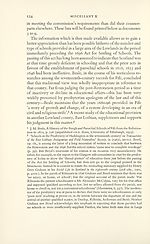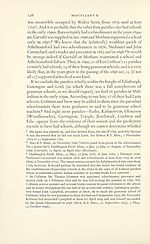Series 4 > Miscellany of the Scottish History Society
(150) Page 125
Download files
Complete book:
Individual page:
Thumbnail gallery: Grid view | List view

LISTS OF SCHOOLMASTERS
125
The lists of schoolmasters which we now print provide further con¬
firmation that over a very considerable area of the central and eastern
Lowlands there was probably so extensive a provision for schooling,
even in the remoter rural districts, that the act of 1696 was not
generally needed in order to establish schools but rather, because of
the widespread hardship of the ‘ill years’, in order to secure the livings
of schoolmasters already in situ. Moreover, and significantly, the lists
show that a very large proportion of these Lowland schools were
grammar schools taught by graduate masters or by teachers who had
attended university classes, and were not merely ‘English’ or ‘Scots’
schools where the curriculum extended only to reading and writing
and perhaps some arithmetic.
Among the sheriffs’ returns which have survived, those for the
counties of East Lothian, Midlothian, Fife and Angus are especially
full1; and from those lists, supplemented by data from other sources
(mainly presbytery and kirk session records), we can construct a
comprehensive picture of the provision for schooling there.
In 1690 the shire of Haddington comprised 25 parishes. We have
entries for 18 of these on the sheriff’s list, leaving Bolton, Garvald,
Bara, Morham, Athelstaneford, Whitekirk and Spott to be accounted
for. The minutes of Spott kirk session on 27 January 1689 record the
death of the schoolmaster and reader, Henry Deans, and the admis¬
sion to these posts of his son, Archibald Deans, ‘a student at the col-
ledge’, who is thus likely to have been able to teach Latin. The first
extant volume of the Whitekirk session minutes opens in 1691, at
which time James Wright was precentor, schoolmaster and session
clerk: he was still teaching the school there in 1717.2 Bolton school
there was no school, yet the Munimenta mentions that ‘Mr John McClane is present
schoolmaster, fitt for that imployment’ although there was no schoolhouse and no
dwellinghouse. In one instance Boyd’s misreading of Graham’s summary leads him
to make a very curious error. It is stated by the moderator of the presbytery that the
Kilbirnie master ‘teaches to read and write, and precents . . . The sallary is 40 merks
Scots and well payed and the casualties. . . .’ Boyd via Graham reports, however, ‘a
salary of 40 merks which with presents goes to a man who teaches to read and write’.
1 It is not possible to argue, however, that a shire for which the return notes only a
few grammar schools must have maintained only that number of Latin masters. As
we shall see, even in the counties for which extensive lists were given in, the sheriffs
did not always provide complete returns of grammar schools there.
2 Whitekirk K.S. Mins., 27 September 1691 to 9 October 1717. Kirk session and
presbytery minutes are quoted from original m s s. in the Scottish Record Office.
125
The lists of schoolmasters which we now print provide further con¬
firmation that over a very considerable area of the central and eastern
Lowlands there was probably so extensive a provision for schooling,
even in the remoter rural districts, that the act of 1696 was not
generally needed in order to establish schools but rather, because of
the widespread hardship of the ‘ill years’, in order to secure the livings
of schoolmasters already in situ. Moreover, and significantly, the lists
show that a very large proportion of these Lowland schools were
grammar schools taught by graduate masters or by teachers who had
attended university classes, and were not merely ‘English’ or ‘Scots’
schools where the curriculum extended only to reading and writing
and perhaps some arithmetic.
Among the sheriffs’ returns which have survived, those for the
counties of East Lothian, Midlothian, Fife and Angus are especially
full1; and from those lists, supplemented by data from other sources
(mainly presbytery and kirk session records), we can construct a
comprehensive picture of the provision for schooling there.
In 1690 the shire of Haddington comprised 25 parishes. We have
entries for 18 of these on the sheriff’s list, leaving Bolton, Garvald,
Bara, Morham, Athelstaneford, Whitekirk and Spott to be accounted
for. The minutes of Spott kirk session on 27 January 1689 record the
death of the schoolmaster and reader, Henry Deans, and the admis¬
sion to these posts of his son, Archibald Deans, ‘a student at the col-
ledge’, who is thus likely to have been able to teach Latin. The first
extant volume of the Whitekirk session minutes opens in 1691, at
which time James Wright was precentor, schoolmaster and session
clerk: he was still teaching the school there in 1717.2 Bolton school
there was no school, yet the Munimenta mentions that ‘Mr John McClane is present
schoolmaster, fitt for that imployment’ although there was no schoolhouse and no
dwellinghouse. In one instance Boyd’s misreading of Graham’s summary leads him
to make a very curious error. It is stated by the moderator of the presbytery that the
Kilbirnie master ‘teaches to read and write, and precents . . . The sallary is 40 merks
Scots and well payed and the casualties. . . .’ Boyd via Graham reports, however, ‘a
salary of 40 merks which with presents goes to a man who teaches to read and write’.
1 It is not possible to argue, however, that a shire for which the return notes only a
few grammar schools must have maintained only that number of Latin masters. As
we shall see, even in the counties for which extensive lists were given in, the sheriffs
did not always provide complete returns of grammar schools there.
2 Whitekirk K.S. Mins., 27 September 1691 to 9 October 1717. Kirk session and
presbytery minutes are quoted from original m s s. in the Scottish Record Office.
Set display mode to:
![]() Universal Viewer |
Universal Viewer | ![]() Mirador |
Large image | Transcription
Mirador |
Large image | Transcription
Images and transcriptions on this page, including medium image downloads, may be used under the Creative Commons Attribution 4.0 International Licence unless otherwise stated. ![]()
| Scottish History Society volumes > Series 4 > Miscellany of the Scottish History Society > (150) Page 125 |
|---|
| Permanent URL | https://digital.nls.uk/126694683 |
|---|
| Description | Over 180 volumes, published by the Scottish History Society, containing original sources on Scotland's history and people. With a wide range of subjects, the books collectively cover all periods from the 12th to 20th centuries, and reflect changing trends in Scottish history. Sources are accompanied by scholarly interpretation, references and bibliographies. Volumes are usually published annually, and more digitised volumes will be added as they become available. |
|---|


